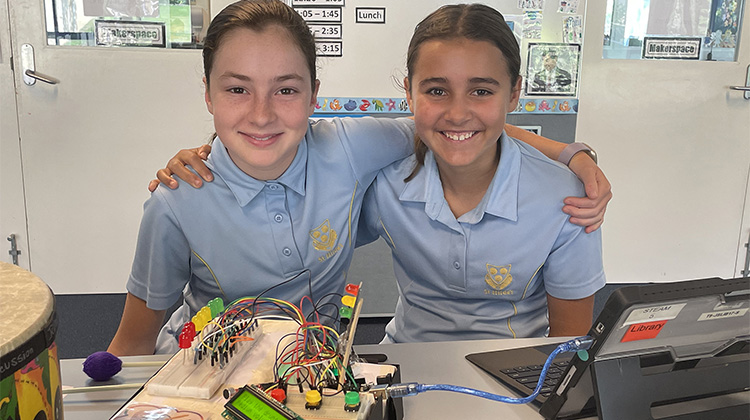Students Bridge Disability with Code

Year 6 students in Perth have invented a device that makes music lessons easier for people with hearing impairments.
As part of a program run by CSIRO, students at St Hilda’s Anglican School for Girls have been learning about Arduino computer coding, which is used to create and control electronic devices, from local IT expert Sheree Pudney.
Ms Pudney volunteers her time through CSIRO’s STEM Professionals in Schools program, designed to give students an insight into real-world careers in the area.
Students Miette Egerton-Warburton, 12, and Elizabeth Townsley, 11, used these lessons to solve a challenge some music teachers face – how to communicate to hearing impaired students how hard to strike the drums – by using coding to create a computer-controlled aid for teachers.
The ‘Hearing Impaired LED’ device lights up with LED bulbs to show students, visually, whether they are striking the drums accurately, too hard, or too soft, and won the team second place in the national Young ICT Explorers awards, run by SAP recently.
CSIRO Director for Education and Outreach, Ruth Carr said this application of creativity and technology has real benefits to society and illustrates the importance of initiatives to boost STEM education.
“As Australia’s national science agency, CSIRO is working to solve the country’s greatest challenges, so we are proud to facilitate a program that helps to inspire the next generation of problem solvers," Ms Carr said.
“Women are underrepresented in STEM industries. Changing this starts with having more visible, female STEM role models, and highlighting the learning and career pathways that are open to students."
St Hilda’s Director of Discovery, Danelle Cross said that authentic learning encourages students to learn through hands-on, collaborative and action-based learning projects and address real problems relevant to students' lives.
“Authentic learning opportunities are vital in schools, as real projects with purpose and meaning beyond the classroom equal more engaged students and ultimately, a future ready workforce,” Ms Cross said.
Sheree Pudney is one of over 1200 STEM professionals nationwide who has volunteered for the CSIRO STEM Professionals in Schools program, which is supported by the Australian Government Department of Education, Skills and Employment.
Ms Pudney has helped inspire approximately 350 students to code over her five years at St Hilda’s and finds it rewarding to contribute to students’ learning.
“Volunteering for the program is an opportunity to teach students, to show them they can do something that they didn't think they could, and to have girls enjoy and achieve in STEM activities. I just love hearing the girls yell out 'it works!' and see the look of amazement on their faces,” said Ms Pudney.
“I'm constantly amazed at the incredible ideas the students come up with. They are so enthusiastic, totally engaged, and inquisitive. They’re brimming with ideas for solving problems, they work well together, and are just so excited and proud of their work.”